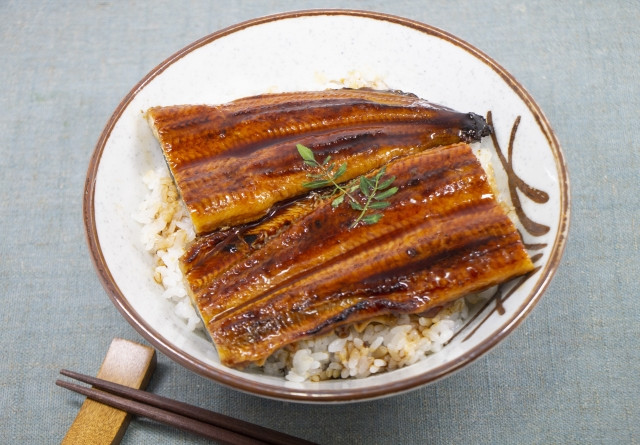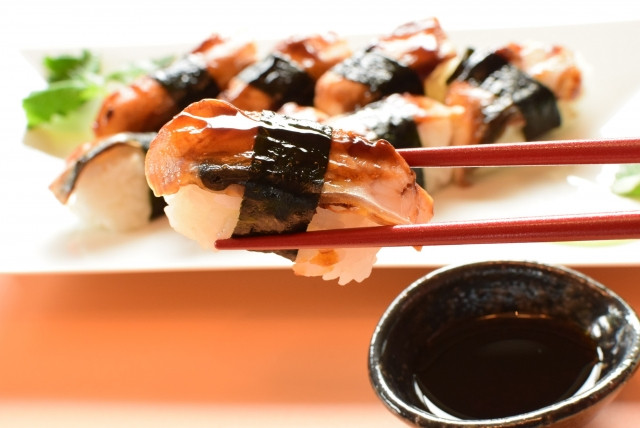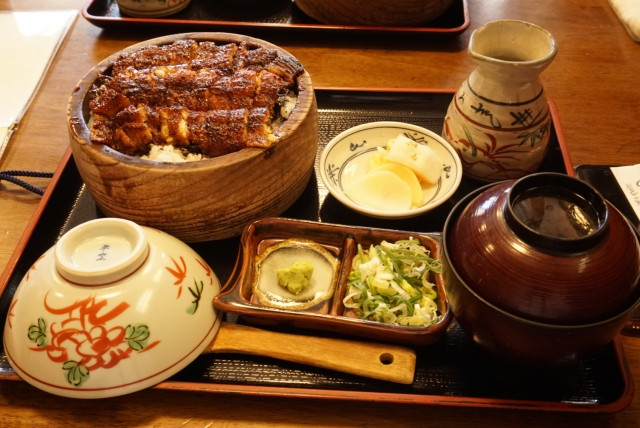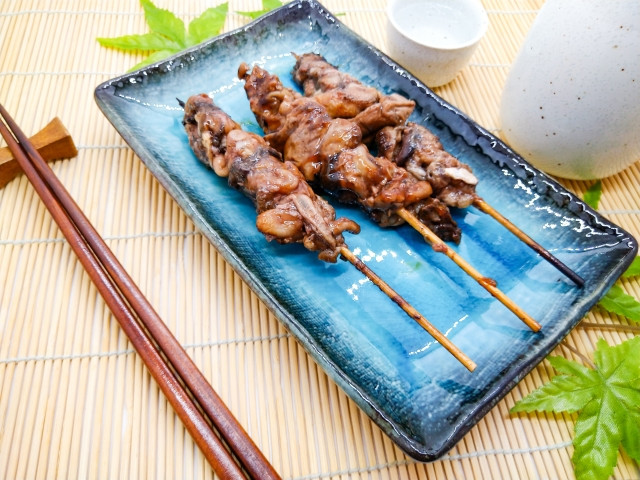Unagi is Japanese for freshwater eel. It is generally quite expensive and carries the image of a luxury meal or dish. Unagi dishes use minimal ingredients as the eel is the main star. It is usually associated with summer as a nutritious dish or meal to replenish energy.
Table of Contents
Introducing Japanese Freshwater Eel

What is Unagi?
Unagi, うなぎ or 鰻, is Japanese freshwater eel. It is available to eat all year round with peak seasons in the summer months, thus being known as a summer food thanks to its rich nutritional value for energy and vitality to withstand the summer heat. Common methods of preparation are grilling, broiling and smoking.
History of Unagi
Over 5,000 years; that’s how long unagi has been in Japanese cuisine history. Archaeological discoveries have uncovered unagi bones from shell mounds showing that they were eaten as far back as the Jomon prehistoric period. Additionally, a reference to unagi has also appeared in Nara period literature. In the anthology Man'yōshū, a character recommended unagi to relieve weight loss from summer fatigue.
The turning point for unagi came during the Edo Period when Unagi Kabayaki, the most famous and classic of unagi dishes, was created. Prior to that, unagi was usually prepared by steaming and lightly salted. The original kabayaki method was grilling/roasting skewered unagi over a charcoal fire. In the Muromachi period, the kabayaki method evolved to include seasoning the eel before grilling. The present day method of kabayaki involving basting thick sweet soy sauce over the eel whilst grilling only appeared in the Tenpo era - around the mid 1800s.
※ Unagi Star, “うなぎの歴史”
Differences Between Unagi and Anago
Unagi is sometimes confused with anago, あなご or 穴子, which is seawater eel. Aside from their appearances, the two could not be more different however:
-
Different methods of preparation - anago is commonly deep-fried
-
Different textures - unagi has more “bite” to it. It also has a fatty layer whilst anago is mostly flesh.
-
Different taste - unagi is more flavourful and usually cooked with sweet sauces whilst anago has a lighter delicate flavour
-
DIfferent nutrition levels - unagi is way more nutritious than anago with quadruple the amount of Vitamin A and much more Vitamin B. It also contains double the amount of calories than anago which means more energy recovery
-
Different prices - unagi is more expensive than the affordable anago
Writer's Pick
Mouth-Watering Unagi Dishes
Without further ado, time to enter the main part of this article which is introducing some unagi dishes:
Unagi Kabayaki

One of the best ways to enjoy unagi is the traditional method of preparation Unagi Kabayaki that was created and made famous during the Edo era. The cooking style has gone through several changes. After deboning, the eel is cut into squarish pieces, skewered, and grilled over charcoal fire. Basting special unagi sauce whilst flipping the eel is the key to its deliciousness. There is an art in kabayaki; kabayaki speciality restaurants with experienced highly trained chefs cost quite a lot to dine at.
Shirayaki
This dish follows the same cooking method as kabayaki except for sauce. The eel retains its original flavour only flavoured minimally with salt. Its appearance more closely resembles anago in this form.
Unadon

Or unagi donburi (unagi rice bowl) is basically unagi over rice. The unagi is usually prepared kabayaki style. The sweet saltiness of the sauce-covered unagi goes best with freshly cooked rice.
Unagi Nigiri

Aka unagi sushi is commonly available in sushi restaurants, and even kaiten sushi (though not the cheapest plate ones). At kaiten sushi, you may mistake anago for unagi. The easiest way to differentiate is their colouring; anago is light faded brown whilst unagi is a dark brown. Another way is by price, as anago is cheap.
Hitsumabushi

A local speciality of Nagoya, Hitsumabushi is a bowl of grilled eel over rice. Not to be mistaken for unadon, hitsumabushi is a high-class expensive meal with a unique method of eating.
How to Eat Hitsumabushi?
-
Start by dividing the eel and rice into four portions.
-
Eat the first portion as it is.
-
Mix the second portion with chopped green onions, seaweed strips, and wasabi, the amount as you like.
-
Eat the third portion chazuke-style with the provided dashi. You can use the same condiments as the second portion if you like.
-
The last portion is for you to finish up the meal with one of the three methods you liked best.
Kimoyaki

Kimo 肝 is liver. Unagi kimoyaki is grilled eel liver. It is a common dish in unagi restaurants. A number of livers, usually 6, are skewered then grilled over charcoal fire. It goes very well with beer.
Kabutoyaki
Kabutoyaki is grilled fish head, or in this case grilled unagi head. Just like kimoyaki, it can be quite a challenge to eat for those not used to it. Kabutoyaki is prepared in the same manner as kimoyaki.
Unagi Pie

Unagi pie is a pastry made from powdered unagi, flour, butter, and sugar. Although it’s called pie, there’s nothing remotely pie-like about this sweet confectionary though the pastry has sort of a danish-pie crust texture. It is a popular souvenir item that is available in airport duty-free shops.
Where to Eat Unagi
It’s time to dine on delicious unagi! Here are some places to go:
Hamamatsu
Hamamatsu in Shizuoka Prefecture is most famous in Japan for unagi. It is the largest producer of unagi with plenty of eel farms. Naturally, there are plenty of unagi specialist restaurants available here with freshly sourced eels.
To learn more about Hamamatsu, have a look at this article by Google Arts & Culture.
For a list of unagi specialist restaurants in Hamamatsu, check
here.
Nagoya
Visit Nagoya and partake in its local delicacy of Hitsumabushi. Here are some restaurants to try:
-
Houraiken, best place by far
-
Maruya, Tokyo branch available in Akasaka area
-
Bincho, Tokyo branches available in Ginza, Ikebukuro, Marunouchi, Skytree, etc.
Nodaiwa
⭐One Michelin-star unagi restaurant Nodaiwa has a long history of over 200 years serving unagi kabayaki. A family-run business, the establishment is now proudly owned by their 5th generation owner. Nodaiwa preserves the traditional Edo-style of cooking unagi. They also serve shirayaki, unadon, chawanmushi, and other unagi dishes and side-dishes.
※ Michelin Guide, "Nodaiwa Azabu Iikura Honten"
Summary
Unagi is a traditional and historical ingredient, dish, and meal in Japanese cuisine. For years, it has been enjoyed as a nutritious summer special. For first timers, it might seem intimidating to eat eel but trust us; it is scrumptious and may well be your favourite Japanese food after you try. The high price may also be a put-off, in which case you can just try a mouth-sized bite at kaiten sushi for reasonable prices. It won’t be enough, or taste the best, but it makes for a good first try.
































